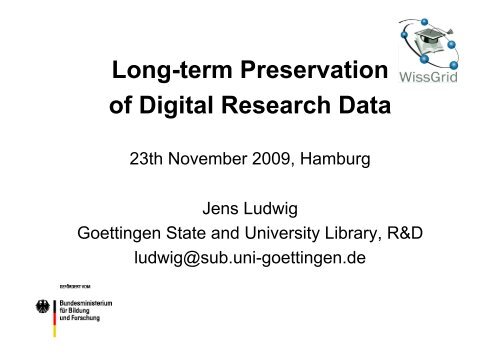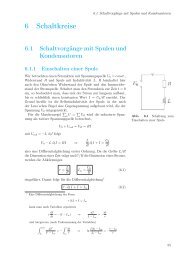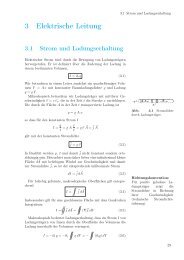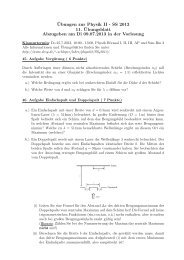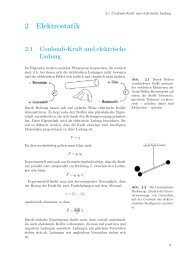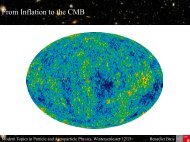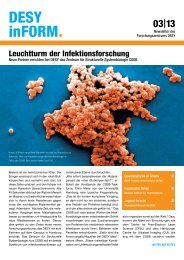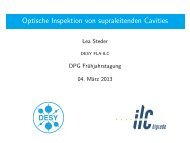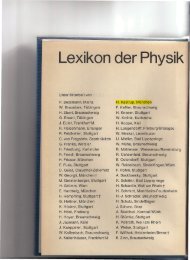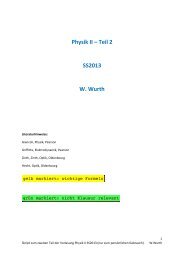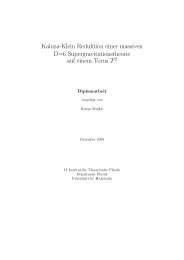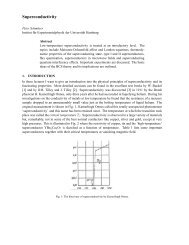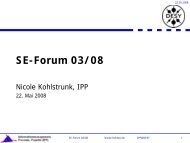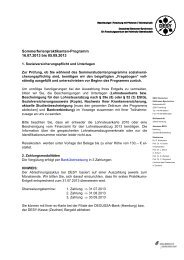Long-term Preservation of Digital Research Data - Desy
Long-term Preservation of Digital Research Data - Desy
Long-term Preservation of Digital Research Data - Desy
You also want an ePaper? Increase the reach of your titles
YUMPU automatically turns print PDFs into web optimized ePapers that Google loves.
<strong>Long</strong>-<strong>term</strong> <strong>Preservation</strong><br />
<strong>of</strong> <strong>Digital</strong> <strong>Research</strong> <strong>Data</strong><br />
23th November 2009, Hamburg<br />
Jens Ludwig<br />
Goettingen State and University Library, R&D<br />
ludwig@sub.uni-goettingen.de
Remarks in Advance<br />
<strong>Long</strong>-<strong>term</strong> preservation does not mean only storing!<br />
Basically: What has to be done to ensure<br />
reuseability <strong>of</strong> digital objects in a different context<br />
(temporal, tech., subject-specific, org., ...)?
Overview<br />
• The digital age and the relevance <strong>of</strong> long<strong>term</strong><br />
preservation<br />
• Structure <strong>of</strong> the challenge and components <strong>of</strong><br />
the „solutions“<br />
• What is happening in HEP and in WissGrid?
Overview<br />
• The digital age and the relevance <strong>of</strong> long<strong>term</strong><br />
preservation<br />
• Structure <strong>of</strong> the challenge and components <strong>of</strong><br />
the „solutions“<br />
• What is happening in HEP and in WissGrid?
Analog Age<br />
Classic memory institutions like<br />
• libraries<br />
• archives<br />
• museums<br />
have collected and preserved information since<br />
thousands <strong>of</strong> years.<br />
Information carriers like stone, clay tablets,<br />
paper and micr<strong>of</strong>ilm are relatively durable, have<br />
low data density and few presuppositions.
<strong>Digital</strong> Age<br />
In culture, science and administration nearly all<br />
information is produced digital:<br />
• Publications<br />
• Records <strong>of</strong> public administration and companies<br />
• Audio, Video, Images, ...<br />
• S<strong>of</strong>tware applications<br />
• Email,<br />
• Internet sites<br />
• ...<br />
• and <strong>of</strong> course: research data<br />
And digital data is harder to preserve...
Why is preservation<br />
important?<br />
• Fundamental liability <strong>of</strong> politics,<br />
administration, companies, ...<br />
• Fundamental for progress and reflection: We<br />
have to stand on the shoulders <strong>of</strong> giants...<br />
• Personal emotional value: pictures, emails,<br />
even sms, ...
Why is preservation<br />
important?<br />
We are interested in the correspondence <strong>of</strong><br />
famous people <strong>of</strong> the past. The famous people<br />
<strong>of</strong> the future have today a facebook site or write<br />
emails.<br />
Not everything has to be preserved, but<br />
probably everywhere something.
Why is preservation <strong>of</strong><br />
research data important?<br />
• Good scientific practice and prevention <strong>of</strong> fraud<br />
• Later, improved analysis <strong>of</strong> old data<br />
• Not all data is reproducible (climate measurements,<br />
astronomy or e.g. for cost reasons)<br />
• „<strong>Research</strong> cannot flourish if<br />
data are not preserved and<br />
made accessible. All<br />
concerned must act<br />
accordingly.“<br />
Nature 461, 145 (10 September 2009),<br />
doi:10.1038/461145a
Overview<br />
• The digital age and the relevance <strong>of</strong> long<strong>term</strong><br />
preservation<br />
• Structure <strong>of</strong> the challenge and components <strong>of</strong><br />
the „solutions“<br />
• What is happening in HEP and in WissGrid?
Model <strong>of</strong> <strong>Digital</strong> Objects<br />
digital object<br />
conceptual object<br />
logical object<br />
physical object<br />
digital<br />
research object<br />
research data/values<br />
formats, e.g. image and<br />
markup files<br />
bit sequence on e.g.<br />
magnetic tape<br />
derived from Thibodeau: Overview <strong>of</strong> Technological Approaches to <strong>Digital</strong><br />
<strong>Preservation</strong> and Challenges in Coming Years, 2002. http://www.clir.org/<br />
pubs/reports/pub107/thibodeau.html
Dangers for <strong>Digital</strong> Objects<br />
• on the physical level<br />
• decay <strong>of</strong> media: complete failure, read errors, bit rot<br />
• obsolescence <strong>of</strong> hardware: missing drives<br />
• on the logical layer:<br />
• obsolescence <strong>of</strong> s<strong>of</strong>tware: application no longer available<br />
or incompatibility<br />
• obsolescence <strong>of</strong> formats: wordstar file format<br />
• on the conceptual layer:<br />
• changes in the background and context knowledge:<br />
change <strong>of</strong> scentific concepts, lacking documentation/<br />
metadata, ...
And “Normal” Dangers<br />
• human error<br />
• technical failures<br />
• disasters<br />
• security gaps, sabotage<br />
• ...<br />
But also<br />
• lack <strong>of</strong> funding<br />
• lack <strong>of</strong> qualified staff<br />
• lack <strong>of</strong> rights (copyright!)<br />
• lack <strong>of</strong> awareness<br />
• ...
Sometimes it looks even similiar to<br />
decay in the paper world:
Terminology for <strong>Preservation</strong><br />
No precise <strong>term</strong>inology yet<br />
Overall: long-<strong>term</strong> preservation (LTP)<br />
In detail:<br />
digital object<br />
conceptual object<br />
logical object<br />
physical object<br />
digital<br />
research object<br />
research data/<br />
values<br />
formats, e.g. image<br />
and markup files<br />
bit sequence on e.g.<br />
magnetic tape<br />
<strong>Data</strong> Curation<br />
(intellectual reuse)<br />
Content <strong>Preservation</strong><br />
(techical reuse)<br />
Bitstream <strong>Preservation</strong><br />
(technical identity)
Tasks (from the perspective<br />
<strong>of</strong> the Object)<br />
• physical-technical object:<br />
– ensuring the integrity <strong>of</strong> the bitstream<br />
– sufficient copies with different locations, institutions and<br />
technologies, regular integrity checks<br />
• logical-technical object:<br />
– ensuring the technical validity and usability<br />
– persistent identification, technical quality control,<br />
preservation actions like format conversion/migration or<br />
providing emulators, ...<br />
• intellectual object:<br />
– ensuring intellectual interpretability and usability<br />
– planing <strong>of</strong> data model and metadata, versioning <strong>of</strong> objects,<br />
maintaining access rights, appraisal, collection building,<br />
intellectual enrichment/linking, ...
Main Solution Strategies<br />
• Bitstream <strong>Preservation</strong>:<br />
– Replication, integrity checks, ...<br />
• Content <strong>Preservation</strong>:<br />
– Migration: adapting object to new tech. environment<br />
(but can introduce errors, authenticity difficult to judge)<br />
– Emulation: adapting tech. environment to old object<br />
(but you have to use the old and outdated environment)<br />
• <strong>Data</strong> Curation<br />
– Provide metadata and context information
Implementation <strong>of</strong> Strategies<br />
LTP is an ongoing task and can not be solved by<br />
technology alone (like in the analog world).<br />
Accelerated obsolescence is equivalent to<br />
accelerated progress .<br />
For large amounts <strong>of</strong> data these strategies can<br />
not be implemented<br />
• without technical infrastructure or<br />
• without a political und organisational framework
Examples for International<br />
Developments<br />
• Standards for long-<strong>term</strong> preservation<br />
– archive reference model (OAIS)<br />
– metadata sets (e.g. PREMIS)<br />
– criteria catalogues (e.g. TRAC)<br />
• Systems, tools<br />
– JHOVE (framework for validation <strong>of</strong> file formats<br />
and technical metadata extraction)<br />
– international file format registries (PRONOM, The<br />
National Archives <strong>of</strong> the UK)<br />
• Organisations<br />
– <strong>Research</strong> data centers and infrastructure<br />
(<strong>Data</strong>Net/US, ANDS/AUS, UKRDS/UK)
OAIS Reference Model<br />
• Originated in the aerospace sector<br />
• Defines functionalities and information types<br />
• No prescriptions for implementation<br />
• main benefit: basic common <strong>term</strong>inology<br />
• Consultative Committee for Space <strong>Data</strong><br />
Systems: Reference Model for an Open<br />
Archival Information System (OAIS). CCSDS<br />
2002.<br />
• http://public.ccsds.org/publications/archive/650x0b1
OAIS overview
OAIS in Detail (just to impress you)
Criteria Catalogues<br />
• Problem: success <strong>of</strong> LTP can be de<strong>term</strong>ined only<br />
in hindsight<br />
• criteria catalogues define instead what<br />
trustworthiness means for an archive<br />
• typical types <strong>of</strong> criteria<br />
– organisational frame (e.g. financing)<br />
– treatment <strong>of</strong> objects (e.g. integrity checks)<br />
– infrastructure and security<br />
• e.g. TRAC http://www.crl.edu/archiving-preservation/digital-archives/<br />
metrics-assessing-and-certifying<br />
• e.g. http://dataseal<strong>of</strong>approval.org/
Metadata<br />
Necessary for management and reuse <strong>of</strong> data<br />
• „Representation Information“<br />
– Metadata about technical implementation and<br />
system requirements<br />
– Metadata about the semantic <strong>of</strong> the data, for<br />
intellectual reuse<br />
• Provenance metadata<br />
• Descriptive metadata<br />
• Fixity, Context, Reference, ...<br />
• e.g. PREMIS: http://www.loc.gov/standards/premis/
<strong>Research</strong> <strong>Data</strong> Centers and<br />
Infrastructure<br />
• <strong>Data</strong>Net initiative in the USA<br />
– 100 Mil. Dollar in five yeas (just started)<br />
– create five discipline specific data centers<br />
• ANDS in Australia<br />
– 50 Mil. Australian Dollars in ten years<br />
– create common infrastructure (for e.g. persistent<br />
identification similiar to DOI for research data)<br />
• UKRDS in UK<br />
– pilot project for creating a shared research data service<br />
• And <strong>of</strong> course already established ones like the<br />
World <strong>Data</strong> Centers (primarily earth sciences)
Overview<br />
• The digital age and the relevance <strong>of</strong> long<strong>term</strong><br />
preservation<br />
• Structure <strong>of</strong> the challenge and components <strong>of</strong><br />
the „solutions“<br />
• What is happening in HEP and in WissGrid?
HEP overview<br />
• Rolf-Dieter Heuer (CERN and former DESY):<br />
Need for open data formats and explication <strong>of</strong><br />
implicit knowledge for reuse<br />
http://www.computerweekly.com/Articles/2008/08/06/231762/in-search-<strong>of</strong>the-big-bang.htm<br />
• CERN is member <strong>of</strong> PARSE.Insight<br />
– EU project which develops a roadmap and<br />
recommendations for a european preservation<br />
infrastructure<br />
• ICFA Study Group on <strong>Data</strong> <strong>Preservation</strong> and<br />
<strong>Long</strong> Term Analysis in HEP
PARSE.Insight<br />
Holznera, Igo-Kemenes, Melea: „First results from<br />
the PARSE.Insight project: HEP survey on data<br />
preservation, re-use and (open) access“<br />
http://arxiv.org/pdf/0906.0485<br />
• about 1200 responses<br />
• 69% see preservation as very important or crucial<br />
• only 16% think that their institution has the<br />
necessary resources<br />
• about 40% suspect that relevant data has already<br />
been lost (not in that article)
ICFA Group on <strong>Data</strong> Pres. and<br />
<strong>Long</strong> Term Analysis in HEP<br />
• http://dphep.org/<br />
• Started with a series <strong>of</strong> workshops this year<br />
(January/DESY, May/SLAC, Dec./CERN, ...)<br />
• The different experiments report their<br />
experiences with <strong>Data</strong> <strong>Preservation</strong><br />
– e.g. migration <strong>of</strong> data formats<br />
– e.g. keeping s<strong>of</strong>tware alive<br />
• Working groups dealing with differenct<br />
aspects
Reuse Story from the 1st<br />
Workshop<br />
• Siegfried Bethke (Max-Planck-Institut for physics),<br />
„Experience from re-analysis <strong>of</strong> PETRA (and LEP)<br />
<strong>Data</strong>“, http://indico.cern.ch/getFile.py/access?<br />
contribId=11&sessionId=3&resId=0&materialId=slide<br />
s&confId=42722<br />
• The JADE Experiment at the PETRA e+e– storage<br />
ring @ DESY, operation time:1978 – 1986<br />
• It was possible to get new results from old data with<br />
new insights although ...
Reuse Story from the 1st<br />
Workshop<br />
• A lot <strong>of</strong> know-how was stored in private accounts and lost<br />
• For reuse it was necessary to:<br />
– copy data from old tapes to new media<br />
– convert some old data formats to new ones<br />
– rewrite and adapt JADE s<strong>of</strong>tware to new platforms<br />
– track missing s<strong>of</strong>tware and data all over the planet<br />
• „Jan Olsson, when cleaning up his <strong>of</strong>fice in ~1997, found<br />
an old ASCII-printout <strong>of</strong> the JADE luminosity file.<br />
Unfortunately, it was printed on green recycling paper - not<br />
suitable for scanning and OCR-ing. A secretary at Aachen<br />
re-typed it within 4 weeks. A checksum routine found (and<br />
recovered) only 4 typos.“
LTP in HEP from an<br />
Outsider Perspective<br />
• It should be easier for HEP than for other<br />
disciplines<br />
– because it is Big Science<br />
– limited data sources<br />
– very organised<br />
– a „lot“ <strong>of</strong> money<br />
– high technology affinity<br />
• But:<br />
– Infrastructure and IT is probably highly proprietary<br />
and uncommon<br />
– high responsibilty and need to justify: don‘t let that<br />
JADE thing happen again?
So, what is this Logo about? -><br />
• WissGrid is a new project <strong>of</strong> the five scientific<br />
grid projects (HEPGrid, C3-Grid, MediGrid,<br />
AstroGrid-D, TextGrid) in D-Grid<br />
• Basic aims: sustainability and propagation <strong>of</strong><br />
Grid for academic users in Germany<br />
– operational model, grid user representation and<br />
independent financing<br />
– consulting <strong>of</strong> communities interested in grid tech.<br />
– and: provide basic tools and know-how for<br />
preservation <strong>of</strong> research data with grid technology
LTP <strong>of</strong> <strong>Research</strong> <strong>Data</strong><br />
in WissGrid<br />
Reasons for LTP with grid technology<br />
• Grid provides abstraction from underlying<br />
technology<br />
• Grid resources benefitial for storage <strong>of</strong> huge<br />
amounts <strong>of</strong> data and e.g. task like file format<br />
conversion<br />
• LTP is a task for the whole life-cycle from<br />
production to arching to reuse. And the grid is<br />
part <strong>of</strong> this life-cycle.
What will the LTP-WP <strong>of</strong><br />
WissGrid do?<br />
• pre-configured systems<br />
– research data repository<br />
– provenance registry<br />
• frameworks for<br />
– metadata extraction from files<br />
– validation <strong>of</strong> file formats<br />
– conversion <strong>of</strong> file formats<br />
• guidelines for LTP <strong>of</strong> research data
What will the LTP-WP <strong>of</strong><br />
WissGrid do?<br />
WissGrid =<br />
Community =<br />
D-Grid/Infrastructure provider =<br />
provenance<br />
servi<br />
ce<br />
research<br />
data<br />
repository<br />
systems<br />
integrity service<br />
LTP<br />
guidelines<br />
metadata<br />
extraction<br />
replication<br />
virtual research environment<br />
validation<br />
format<br />
conversion<br />
<strong>Data</strong><br />
Curation<br />
Content<br />
<strong>Preservation</strong><br />
Bitstream<br />
<strong>Preservation</strong>


